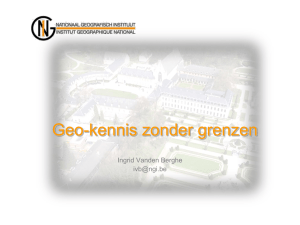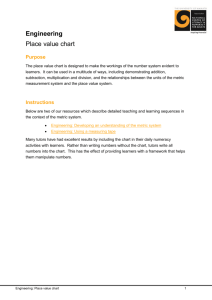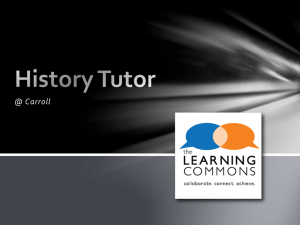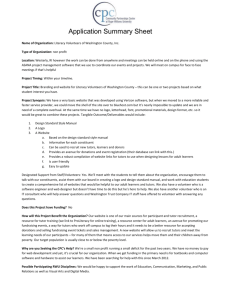EXPERIENCES WITH COMBINING E-LEARNING COURSES WITH FACE-TO-FACE EDUCATION
advertisement
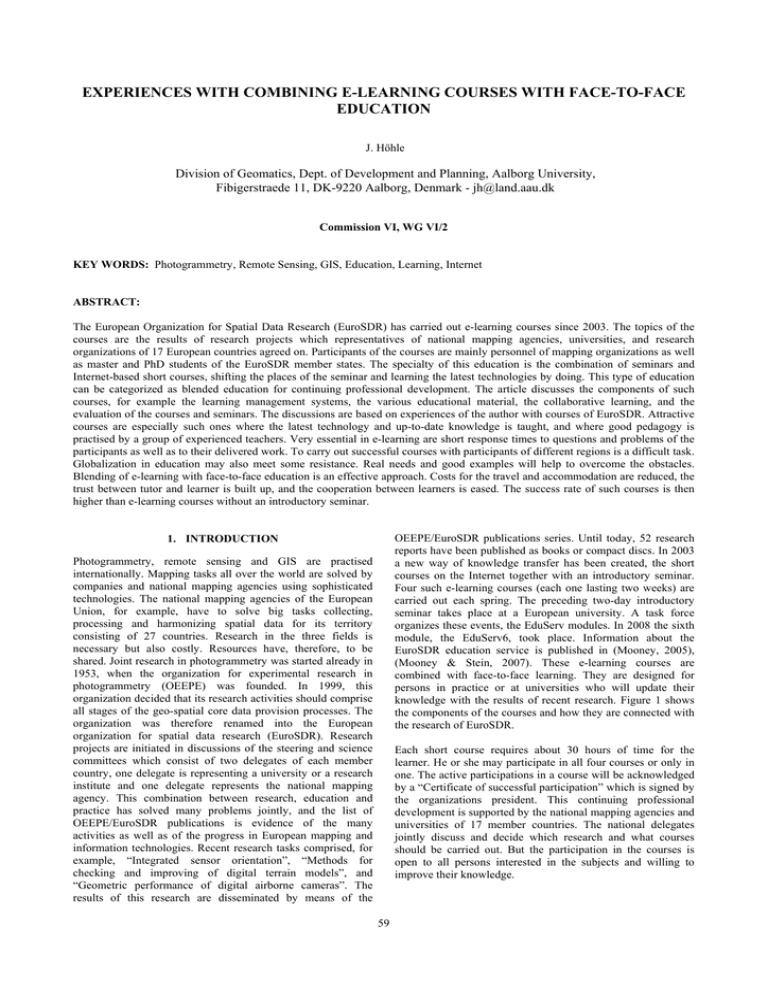
EXPERIENCES WITH COMBINING E-LEARNING COURSES WITH FACE-TO-FACE EDUCATION J. Höhle Division of Geomatics, Dept. of Development and Planning, Aalborg University, Fibigerstraede 11, DK-9220 Aalborg, Denmark - jh@land.aau.dk Commission VI, WG VI/2 KEY WORDS: Photogrammetry, Remote Sensing, GIS, Education, Learning, Internet ABSTRACT: The European Organization for Spatial Data Research (EuroSDR) has carried out e-learning courses since 2003. The topics of the courses are the results of research projects which representatives of national mapping agencies, universities, and research organizations of 17 European countries agreed on. Participants of the courses are mainly personnel of mapping organizations as well as master and PhD students of the EuroSDR member states. The specialty of this education is the combination of seminars and Internet-based short courses, shifting the places of the seminar and learning the latest technologies by doing. This type of education can be categorized as blended education for continuing professional development. The article discusses the components of such courses, for example the learning management systems, the various educational material, the collaborative learning, and the evaluation of the courses and seminars. The discussions are based on experiences of the author with courses of EuroSDR. Attractive courses are especially such ones where the latest technology and up-to-date knowledge is taught, and where good pedagogy is practised by a group of experienced teachers. Very essential in e-learning are short response times to questions and problems of the participants as well as to their delivered work. To carry out successful courses with participants of different regions is a difficult task. Globalization in education may also meet some resistance. Real needs and good examples will help to overcome the obstacles. Blending of e-learning with face-to-face education is an effective approach. Costs for the travel and accommodation are reduced, the trust between tutor and learner is built up, and the cooperation between learners is eased. The success rate of such courses is then higher than e-learning courses without an introductory seminar. OEEPE/EuroSDR publications series. Until today, 52 research reports have been published as books or compact discs. In 2003 a new way of knowledge transfer has been created, the short courses on the Internet together with an introductory seminar. Four such e-learning courses (each one lasting two weeks) are carried out each spring. The preceding two-day introductory seminar takes place at a European university. A task force organizes these events, the EduServ modules. In 2008 the sixth module, the EduServ6, took place. Information about the EuroSDR education service is published in (Mooney, 2005), (Mooney & Stein, 2007). These e-learning courses are combined with face-to-face learning. They are designed for persons in practice or at universities who will update their knowledge with the results of recent research. Figure 1 shows the components of the courses and how they are connected with the research of EuroSDR. 1. INTRODUCTION Photogrammetry, remote sensing and GIS are practised internationally. Mapping tasks all over the world are solved by companies and national mapping agencies using sophisticated technologies. The national mapping agencies of the European Union, for example, have to solve big tasks collecting, processing and harmonizing spatial data for its territory consisting of 27 countries. Research in the three fields is necessary but also costly. Resources have, therefore, to be shared. Joint research in photogrammetry was started already in 1953, when the organization for experimental research in photogrammetry (OEEPE) was founded. In 1999, this organization decided that its research activities should comprise all stages of the geo-spatial core data provision processes. The organization was therefore renamed into the European organization for spatial data research (EuroSDR). Research projects are initiated in discussions of the steering and science committees which consist of two delegates of each member country, one delegate is representing a university or a research institute and one delegate represents the national mapping agency. This combination between research, education and practice has solved many problems jointly, and the list of OEEPE/EuroSDR publications is evidence of the many activities as well as of the progress in European mapping and information technologies. Recent research tasks comprised, for example, “Integrated sensor orientation”, “Methods for checking and improving of digital terrain models”, and “Geometric performance of digital airborne cameras”. The results of this research are disseminated by means of the Each short course requires about 30 hours of time for the learner. He or she may participate in all four courses or only in one. The active participations in a course will be acknowledged by a “Certificate of successful participation” which is signed by the organizations president. This continuing professional development is supported by the national mapping agencies and universities of 17 member countries. The national delegates jointly discuss and decide which research and what courses should be carried out. But the participation in the courses is open to all persons interested in the subjects and willing to improve their knowledge. 59 The International Archives of the Photogrammetry, Remote Sensing and Spatial Information Sciences. Vol. XXXVII. Part B6a. Beijing 2008 Research project A Publication of Report even frustrations. The blended learning tries to avoid these pitfalls. Workshop 3. COURSES OF EUROSDR EuroSDR Design of coursematerial Research plan EduServ is the series of short e-learning courses of EuroSDR. The courses use the Internet and a learning management system (LMS) for communication and control. The courses are preceded by a two-day workshop where participants can meet with each other and with their tutors, hear an overview about the topics and receive all necessary course material and instruction about the use of the LMS. The tutors are members of the working group which carried out a previous research project. The courses are open to all but principally intend to transfer research outcomes and developments to practitioners in the GI production and education environments. Four two-week courses are offered each year. Table 1 contains the list of courses carried out so far. Figure 2 gives an overview of the two main parts of an EduServ module, which includes the introductory workshop/seminar and four courses per year. In the following details about the EduServ modules are presented. e-learning course Evaluation selection of Selection of course courses Time Figure 1. Research and dissemination of knowledge by means of the courses of EuroSDR 2. FACE-TO-FACE LEARNING VERSUS E-LEARNING The education in photogrammetry, remote sensing and GIS is today life-long and has also to take place beside work or studies. Such post-graduate study has special conditions and demands. Short courses at the Internet have to meet the requirements of the employees and of the employers. Costs and times for travel and staying should be low and the learning can take place in the office or at home and in suitable times. The only requirement is the access to the Internet. This e-learning is active learning; the student has to answer questions, solve tasks and carry out exercises. It is learning by doing. Furthermore, the learners can work together and communicate with their fellow learners as well as with their tutors. Such collaborative learning is very beneficial to the learning. Learners will discuss the solutions with each other before they submit it to the teachers. In order to promote such collaborative learning the tutors have to give tasks for a group of students. A lot of literature has been published on e-learning and collaborative learning. The state of the art in elearning applied for education in photogrammetry, remote sensing and spatial information science is recently summarized in (Cho et al., 2008). Face-to-face education is well known. Combining both forms of education, e-learning and face-to-face education, is practised in the courses of EuroSDR. They are an example of blended learning. Features and experiences with this type of learning will be presented in this article. Introductory workshop Introduction to: -course 1 -course 2 -course 3 -course 4 -Learning Management System Social activities e-learning course x Student: -familiarization with LMS -study of literature -self-tests (Quizz) -use of learning programs -solving of tasks -discussion forum -collaborative work Teacher: -feed back Figure 2. The two main parts of the EuroSDR education: Introductory workshop and e-learning courses. 3.1 Educational seminar The Internet-based courses start with a two-day seminar. At this event the courses are introduced. This is usually an overview of the course contents, the educational material and the assignments and hands-on instruction at the used LMS are presented. Other practical work with the teaching material may also be carried out. The event is therefore also a workshop. The participants are informed about the current research. Some social activities are added to the programme. A visit to the laboratories of the hosting university or some sightseeing in the town may also be part of the introduction programme. The seminar is organized at different universities in Europe. So far the seminar was held in Aalborg/Denmark, Budapest/Hungary, Dublin/Ireland, Enschede/The Netherlands, Prague/Czech Republic, and Stuttgart/Germany at an educational institution. Tutors and learners have to become acquainted before the course. This is realized by the introductory workshop. The topics of the courses are introduced. Face-to-face teaching is then practised with the well-known advantages. Tutors will try to motivate students and to start dialogues. The proper use of gestures, eye contact, and voice plays an important role in education. The participants of different background, culture, languages, and age should get together under social events like breaks, meals, excursions, etc. It will ease the collaborative learning. The tutors get a feeling what the attending persons know in advance and how he or she has to adapt his or her way of teaching. Personal contacts between the learner and the tutor and among the fellow learners are therefore very essential in such courses. The drop-out rates of the courses are then reduced and the learning success will increase if the tutor and the learners ‘have a face’. Communication to anonymous persons and only in a written form may lead to misunderstandings, short cuts and About 50 participants (including tutors and organizers) get together at each seminar. Some of the learners attended the workshop for a second time, but then scheduled for different courses. The personal contact between the participants will usually easily develop. Figures 3 may give some impression of the atmosphere at the introductory seminar. 60 The International Archives of the Photogrammetry, Remote Sensing and Spatial Information Sciences. Vol. XXXVII. Part B6a. Beijing 2008 Name of the course Integrated Sensor Orientation Automatic Orientation of Aerial Images on Databases Laser scanning & Airborne Interferometric Synthetic Aperture Radar Digital Cameras/Sensors Co-ordinate Systems & Transformations for Spatial Data Position Positional Accuracy Improvements in Geographic Information Databases Quality of Geospatial Data & Related Statistical Concepts Methods for Checking & Improving of Digital Terrain Models Mapping with Synthetic Aperture Radar Laser Scanning for 3D City Models Geometric Performance of Digital Airborne Cameras City GML Tutors/Affiliation Heipke & Jacobsen, University of Hanover, Germany Höhle & Potuckova, Aalborg University, Denmark Tempfli & Huurneman, ITC Enschede, The Netherlands Toth & Csatho, Ohio State University, USA Mooney & Martin, Dublin Institute of Technology, Ireland Rönsdorf & Geilsdorf, Ordnance Survey, England & TU Berlin, Germany Stein & Tolpekin, ITC Enschede, The Netherlands Höhle & Potuckova, University of Aalborg, Denmark & Charles University Prague, Czech Rep. Hellwich & Reigber & Bellmann TU Berlin, Germany Hyyppä &Kaartinen & Liang, Finnish Geodetic Institute Cramer & Stallmann, University of Stuttgart, Germany Kolbe & Østman, TU Berlin, Germany & University of Gävle, Sweden Table 1. Short courses of the European Organization of Spatial Data Research The last one has been most selected and will therefore be used as an example. In general, all of the applied LMS are very user-friendly, and it does not take many hours to become familiar with it. The LMS integrates all course material, discussions, calendar, and announcements into one environment. The Learning Management System “Moodle” Moodle is designed to help tutors to create e-learning courses with opportunities for interaction. Tutors and learners can contribute to the educational experience in many ways. It is flexible to allow for a full range of modes of teaching. Moodle is open source software and therefore very much used all over the world. After the course participants have logged in with their password, they will see the portal of the course (cf. Figure 4). Under “Participants” they find the profiles of the other participants and of their tutors. The learner can now familiarize himself with the course material at “Resources” and inform himself about important course events at “Calendar”. Other news is announced at bulletin boards. Other possible activities are self-tests (‘quizz’), discussions (‘forum’), personal diaries (‘blog’), and group work (‘wiki’). “Resources” contain the literature and programs. Figure 3. The computer room of the University of Applied Sciences, Stuttgart, where the presentations at the introductory seminar/workshop of EduServ6 took place The communication in Moodle is carried out by e-mails, which can be sent to persons (tutors or fellow learners) or to a group. The “Calendar” is used to inform about events, for example about deadlines for the delivery of answers to assignments. The tutors have the possibility to monitor the activities of the learners. All participants can observe who currently uses the LMS. 3.2 E-learning courses The components of e-learning courses consist of the learning management system, the course material, the pedagogical approach, and the quality control. 3.2.1 Learning management systems The communication between the learners and the tutors is carried out by means of the Learning Management System (LMS). Several of these LMS have been applied in the EuroSDR courses: FirstClass, Blackboard, WebCT and Moodle. 61 The International Archives of the Photogrammetry, Remote Sensing and Spatial Information Sciences. Vol. XXXVII. Part B6a. Beijing 2008 Figure 4. The user interface of the LMS “Moodle”. The left column contains “People”, “Activities” and a “Calendar”, the middle column all course topics (modules) and the right column various bulletin boards 3.2.3 Pedagogical approach The topics of the course modules may include a short description of the contents, the goals to achieve by the selected module, and instructions how to proceed with the learning. The attached literature has to be studied and experiments of the learning programs should be carried out. The learner can then make a self-test. This can be a set of questions with a multiple choice of possible answers (‘quiz’). If a greater percentage of the questions is answered correctly, the learner continues by selecting a task (‘assignment’). He or she sends answers and solutions to the tutor before an announced deadline. Shortly thereafter, the tutor will return standard answers first and somewhat later react with answers to the individual learner. The learner studies the standard answers and the comments of the tutor. He or she may wish to have more explanations to assignments and will use the ‘forum’ where tutors and fellow learners will react to questions or problems encountered. Figure 5 summarizes the procedures for one topic. 3.2.2 Course material All the recommended literature is usually on-line on the Internet. Also written course material, for example the publication containing all details of the research project, may be used and handed out at the introductory seminar. Interactive learning can also be realized by means of special learning programs, which allow for experiments and simulations with the help of dynamic graphs. The programs are produced by means of programming languages (e.g. Java) or special software tools (e.g. Flash). Examples are “Learning Digital Photogrammetry on the Internet” (LDIPInter1/2) and “Automated Orientation of Images” (Auto_Orient), which are part of the course “Automatic Orientation of Aerial Images on Databases”. This software for computer-assisted learning can be used at the Internet (http://www.plan.aau.dk/~jh/ ). Specialized software programs were also used, for example software for integrated sensor orientation (“BLUH” of the University of Hannover and “dgap” of the University of Stuttgart). The last mentioned software package can be accessed at http://www.ifp.unistuttgart.de/publications/software/openbundle/index.en.html). Collaborative learning can be practised when the learners are writing together a report on the experiences about a method. For this purpose ‘wikis’ are created. In principle, the approaches of the tutors in the courses are different. The tutors are recruited from different universities. They will also use the same educational material at their home universities. Therefore, blended learning is not restricted to distance education only, but it is very necessary in distance education as in the EuroSDR courses. Other important course material is data sets, for example images, maps, terrain models, measurements, reference data, etc. Software and data sets are available from the research projects and then used in the courses. A guidance how course material for e-learning in photogrammetry is designed is published in (Höhle, 2004). 62 The International Archives of the Photogrammetry, Remote Sensing and Spatial Information Sciences. Vol. XXXVII. Part B6a. Beijing 2008 study literature short introduction use learning program do self-evaluation d i s c u s s seminar to create possibilities that such contacts will happen. The courses will without doubt benefit from it. fellowstudent The evaluation of the seminar and the courses is also carried out by the group of teachers. A more detailed analysis of all of this ‘feedback’ is done in the chapter about experiences. receive assignments 3.2.5 Acknowledgement of the courses The participation in one course requires about 30 hours of work. This is an average figure and the workload corresponds to one credit point of the European Credit Transfer System (ECTS). The participants receive a “Certificate of attendance” if the assignments have been submitted and evaluated by the tutors as “accepted”. Some universities have acknowledged the course work with ECTS credit points in their PhD programmes. send solutions tutor Topic start Topic end compare solutions standard answer individ. answer Figure 5. Strategy in the learning 3.2.6 Some statistics about EuroSDR courses In 2003 the Educational Service of EuroSDR was started with the first educational seminar and with three e-learning courses. In the following years four courses per year were always carried out, altogether twelve courses and six EduServ modules so far. Figure 6 depicts the development of the number of participants and countries in these six modules. 3.2.4 Assessment of the course and the seminar The EuroSDR working group on education organizes the EduServ modules. By this group of people a hosting university for the seminar and tutors for the courses have to be selected. Experiences from previous seminars and courses play an important role in this selection process. The EduServ modules are all evaluated. This is done by a set of questions which the participants are asked to answer (cf. Table 2). Suggestions for improvements and for new courses are also requested. Number of participants/countries 35 Evaluation of the courses Did you find the course useful? Was the goal of the course achieved? Was the quality of the course material sufficient? Was the provided hardcopy material useful? Was the workload too much for you? Was the length of the course (2 weeks) all right? Did the communication via the ‘LMS’ work for you? Did you receive sufficient feed back from your tutor? Could you monitor a progress in your learning? Did you have useful contacts with your fellow learner? Did the combination of seminar and courses suit you? Was the course too difficult for you? What did you like most about the courses? Suggestions Do you have suggestions for improvements in the courses? Course material: Seminar: Communication with the tutor: Communication with your fellow learners: Do you have suggestions for future topics? Will you take part in a new course if the topic suits you? 30 25 20 15 10 5 0 1 2 3 4 5 6 EduServ module Figure 6. Number of participants (left column) and number of countries (right column) at Eduserv modules In average, 26 persons attended an Eduserv module and 13 persons a course. About every second participant came from another country. Participation was not restricted to member countries of EuroSDR and a few learners from other European countries, Asia and Africa attended as well. 4. EXPERIENCES WITH BLENDED LEARNING The EuroSDR courses are repeated in the following year. Nevertheless, the lifetime of the courses is relatively short, but the efforts for the creation of the course material are high. EuroSDR courses are based on recent research and the transfer of this knowledge to practice is their major objective. The quality of the courses is important as well. Improvements occur and they are based on the evaluation of the participants, teachers and members of the working group. Table 2. Questionnaire regarding the EuroSDR courses. The questions are answered with ‘yes’, ‘sort of’ or ‘no’ The questionnaire regarding the seminar includes also the following questions: From the analysis of the questionnaires the following items are stressed as good practice for blended learning: -short reaction time by the teachers to questions and delivered assignments -progress in learning has to be experienced by the learner -the workload should be manageable and not exceed 30 hours per course -collaborative learning should be encouraged by the tutor Did you find the seminar useful? Did you get in contact with your tutors and fellow participants? Nearly all participants of the six EduServ seminars answered the first question with “Yes”. It was not so with the second question. It needs special efforts by the organizers of the 63 The International Archives of the Photogrammetry, Remote Sensing and Spatial Information Sciences. Vol. XXXVII. Part B6a. Beijing 2008 visualizing of large data sets. Videos and speech recordings will be used as educational material. The dissemination of the latest technology, however, should be done without delays. Quality measures for good courses are the number of given certificates for successful attendance. Also the percentage of repeated participation in EduServ modules is an indicator for the acceptance of courses. Tutors appreciate the active participation and constructive criticism of the learners. Scientists and tutors definitely profit from contacts with practitioners; they may also get satisfaction from the fact that their research is used by other people. ACKNOWLEDGMENTS The author wants to thank all tutors, organizers of workshops/seminars and my colleagues of the EuroSDR working group on education for their contribution to make this global education possible. Thanks belong also to the universities and research organization which enabled their employees to participate in disseminating knowledge of recent research work. Problematic in this type of education is the diversity of the learners. This concerns the technical background, culture, age, ability to communicate, etc. Education under such conditions requires special experiences of the teachers. The EuroSDR courses are carried out in English only. Therefore, participants need to read and to write in English. Writing in a foreign language may lead to some misunderstandings. It needs greater attention and care than at face-to-face education. It may be a matter of time when more persons in Europe and elsewhere agree to learn and to teach in English. There may also be some resistance, especially in countries, which have other possibilities for continuing professional development. On the other hand, carrying out such courses in different languages requires much higher efforts and resources. REFERENCES Cho, K., König, G., Höhle, J., 2008, Educational developments and outreach. In: ISPRS book, 21 pp. Höhle, J., 2004, Designing of course material for e-learning in Photogrammetry. In: International Archives of Photogrammetry, Remotes Sensing and Spatial Information Sciences, Vo. XXXV, Part B6, Istanbul 2004, pp. 89-94. 5. FUTURE OF BLENDED LEARNING COURSES Mooney, K., 2005, EuroSDR’s EduServ Series – Transferring knowledge from the research to the user domain by distance elearning, In: International Archives of Photogrammetry, Remote Sensing and Spatial Information Sciences, Vo. XXXVI-6/W30, Potsdam, Germany, 5p. Many other organizations will offer Internet-based short courses in future. Video and audio technologies will be applied in distance education. For example, communication by means of video conference systems will be practised. The blended learning approach as described in this article will remain, because the courses do not need special equipment and personnel. Furthermore, the personal contacts with tutors and other learners can be established in the introductory seminar. The courses have therefore a good start and the tutors have a ‘face’. The pure written communication has some disadvantages, but subjects like photogrammetry, remote sensing and GIS are based on computation, processing and Mooney, K. and Stein, A., 2007, EduServ : the education service of EuroSDR : building capacity and transferring skills. Presented at INTED 2007 the international technology, education and development conference, 7-9 May, 2007 Valencia, Spain, International Association of Technology, Education and Development (IATED), 8 p. 64
